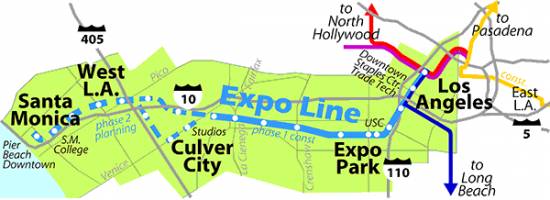
Last night the Expo Construction Authority held a community meeting in the Vista Del Mar Child and Family Services Gymnasium, right in the heart of a community that has historically been opposed to construction of Phase II of the Expo Line. As expected, it was hard to find a supporter of extending light rail from where Phase I ends in Culver City all the way to downtown Santa Monica. In recent days, the Bottleneck Blog has done a great job of covering the controversy.
By now the story is an old one, large segments of West Los Angeles are worried that a light rail whisking through their community at 55 miles per hour will endanger pedestrians and slow traffic at intersections. Because it goes through low-density residential areas, opponents argue that Expo is being built more for the residents of Downtown Los Angeles and Santa Monica than it is for West Angelenos. A group called Neighbors for Smart Rail also argue that the Expo Line could cut off access to the I-10.
On the other side of the issue are Friends for Expo and Light Rail for Cheviot who argue that light rail is proven, popular, and growing nationwide. Over 800,000 people will live within two miles of the completed Expo Line which will provide a valuable transit option for the entire West Los Angeles area. Last night Darrell Clarke showed me an image of gas prices at the corner of Pico and Barrington where regular was going for $4.83 per gallon and premium at $5.13. The unspoken question was how could anyone be opposed to increasing transit when the cost of gas is going to price out middle and lower class car drivers in the near future.
Last night much of the opposition was about grade crossings. Before public comment, the Expo Construction Authority gave a 45 minute presentation that was basically a defense of at-grade (street level) rail crossings. There’s a lot of things Expo and local DOT’s can do to lessen the impact of trains crossing major streets at-grade such as increase the local road capacity by taking away street parking, fixing sidewalks and putting in traffic signals at nearby intersections. In some areas, perhaps because of the increased road capacity, the Expo Authority actually predicted an increase of automobile traffic if the line is built as compared to the no-build alternative.
The authority also stated that 12 trains will come in each direction every hour during the peak period which, when combined with traffic signals, would result in stopped traffic on major roads over half of the time. The authority then went through all of the crossings that they were still studying and made the case for at-grade crossings.
The audience was not impressed.
What happened next was a parade of speakers demanding grade-separated (above or below ground) crossings at either every intersection or just the ones in their community. First to speak was Jay Handal, of the West Los Angeles Chamber of Commerce and President of the Neighborhood Association, who was upset that the study hasn’t also taken into account the large new developments going into West L.A. and the impact they are going to have on traffic in addition to the at-grade crossings. He ended his comments with a plea to , “get these crossings above grade.”
Other speakers included a variety of local residents of all ages, races and genders. Despite rushing through as much testimony as he could get in under the two-minute per speaker limit, Damien Goodmon ran out of time before saying everything he wanted to. When the Authority told him time was up we got our first outburst from the crowd of the evening as the audience jeered the authority and shouted to “Let him talk!” Many other times throughout the night crowd members would shout that the Authority was lying to them or demanding more time for particularly compelling speakers.
Even Ken Alpern, President of the Transit Coalition, called it “absolutely critical” that all grade crossings were grade separated. Karen Leonard of Light Rail for Cheviot was dismayed that the crossing at Westwood would be at-grade although she made clear she supported whatever Expo settled on as long as the Phase II extension is built.
On top of all the complaints about at-grade crossings, members of the cyclist community also showed up to ask about the bike trail that will run parallel to the line. Responding to a question from Kent Strumpell, the Authority admitted that there will probably be gaps in the bike trail which seems to me to be a mistake. All one has to do is look at the overcrowded racks along the Orange Line to know what impacts a completed trail can have on transit ridership.
There were people at the meeting that were for the project, and meetings in a different area would be packed with speakers supporting the project instead of the other way around. The Expo Line is perhaps the most controversial rail project in California and has fervent supporters and opponents throughout South and West Los Angeles.
To dismiss the community’s complaints as ineffective NIMBYism is a mistake. Handal has already proven the muscle to kill a transportation project in court and the Authority is relying on a large grant from the FTA. My guess is the FTA would be loathe to fund a transit project that lacks support in the local community. While proponents of the line argue that grade-separating crossings would be too expensive to secure funding for the line, it could also be that opposition to any project without them could cause the project to never get funding anyway.
Image: Friends for Expo






